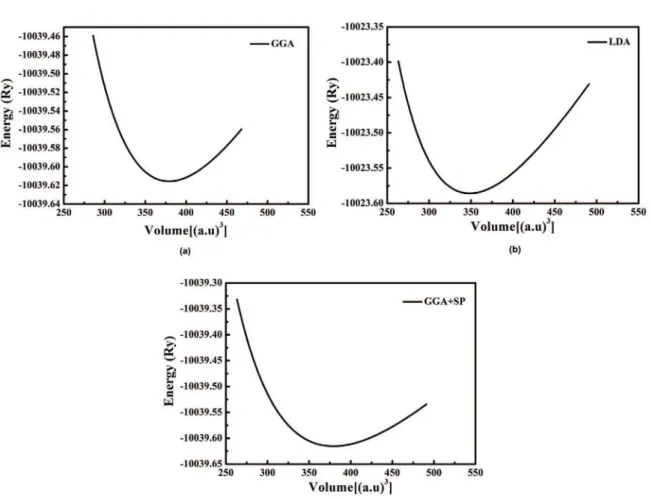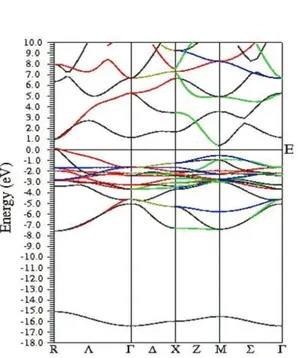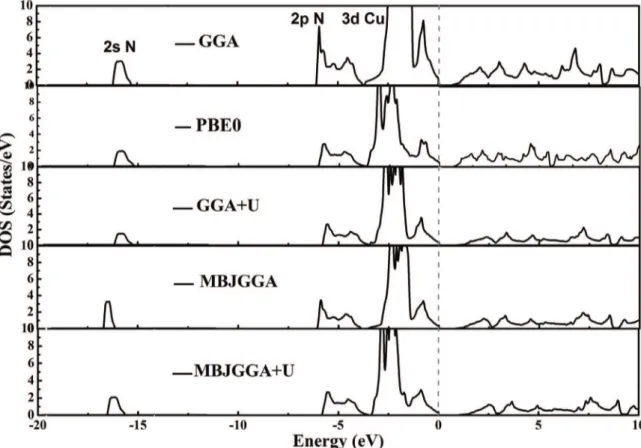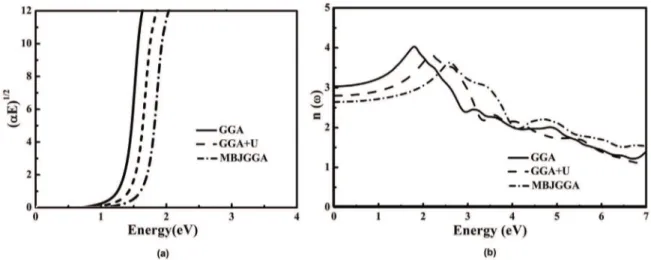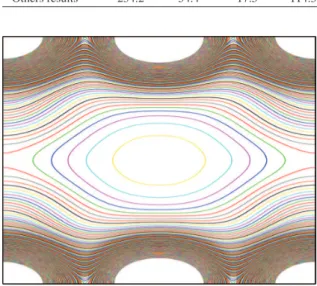*e-mail: a.rahmati@vru.ac.ir
Ab. Initio Study of the Structural, Elastic, Electronic and Optical Properties of Cu
3N
A. Rahmatia,b,c*, M. Ghoohestanid, H. Badehiane, M. Baizaeea
aDepartment of Physics, Faculty of Science, Vali-e-Asr University of Rafsanjan, Rafsanjan, Iran bNano Research Group, Vali-e-Asr University of Rafsanjan, Rafsanjan, Iran cThin Film Laboratory, Faculty of Science, Vali-e-Asr University of Rafsanjan, Rafsanjan, Iran
dNano Research Centre, Department of Physics, Malek Astar University of Technology,
Shahinshahr, Isfahan, Iran
eCondensed Matter Lab, Department of Physics, Faculty of Science, Shahid Chamran University, Ahvaz, Iran
Received: February 20, 2013; Revised: January 14, 2014
Electronic, optical, elastic, properties of Copper nitride (Cu3N) in cubic anti- ReD3 phase have been studied using the full-potential augmented plane waves (FP-LAPW) within density functional theory (DFT) framework. Generalized gradient approximation (GGA), local density approximation (LDA), Perdew– Burke–Ernzerhof generalized parameterization of gradient approximation (GGA-PBE), and new modiied Becke and Johnson GGA (MBJ-GGA) have been used for exchange-correlation potentials. The structural properties such as equilibrium lattice parameter, bulk modulus and its pressure derivative have been obtained and optimized. The Hubbard potential has been enhanced to improve bandgap energy. Dptical properties, such as the dielectric function, refractive index, extinction index, and optical band gap, were calculated for radiation up to 14 eV. The chemical bonding in Cu3N was discussed by three method electronegativity concept, B/G ratio, and charge density distribution. Moreover, Elastic constants, Young’s modulus, shear modulus, Poisson’s ratio, sound velocities for longitudinal and shear waves, Debye average velocity and Debye temperature have been calculated. The estimated structural, elastic and other parameters are in good agreement with experimental data. The calculation exhibits that Cu3N is a direct semiconductor (0.7-1.12 eV) with ductile and ionic identity.
Keywords: band structure, density of states, elastic constants, Debye temperature The PACS: 71.20.Be, 71.20.Gj, 81.05.Bx describe the paper well
1. Introduction
Many interests were concentrated on copper nitride for several reasons; copper nitride can be used as an optical engraving medium for optoelectronic devices1, a barrier
material in spin tunnel junction2, a high density optical
storage media3,4, micrometric conductive dots and lines5 and
good candidate for hybrid inorganic solar cells6.
Copper nitride has several phases among which cubic anti-ReD3 structure is more stable. On this phase Copper nitride has simple cubic structure and is crystallized in space group pm-3 m (221) with atomic positions Cu (0, 0, 0) and N (1/2, 1/2, 1/2). Unit cell of Cu3N is illustrated in Figure 1.
There are always noticeable divergences between values of theoretically calculated band gap energy and experimental ones. According to the theoretical works, Cu3N is semiconductor with narrow band gap in 0.23 to 0.9 eV regions7,8 whereas, experimental results change between
0.8 to 1.9 eV6,9-11.
On this study, we have studied structural, elastic, optical, and electronic properties of yttrium oxide compound in cubic phase using the full-potential augmented plane waves (FP-LAPW) within density functional theory (DFT) framework. Moreover, we have used new approximation for exchange and correlation terms (MBJ-GGA) for band calculation
which greatly improves the band gap. Dur results agree very well with experimental studies. Some experimental results were incorporated to validate theoretical results.
2. Computational Method
density was Fourier expanded up to Gmax = 14 (a.u.)–1.
The exchange– correlation (XC) effect was treated by the generalized gradient approximation (GGA), GGA+U, mBJ and mBj+U. The self-consistent calculations are considered to be converged when the total energy of the system is
stable within 10–4 Ry. The integrals over the irreducible
Brillouin zone (OBZ) are performed up to 35 k-points, using the Monkhorst–Pack special k-points approach13. To validate the results, the calculated relectance spectra, refractive index and absorption coeficient were compared with their corresponding experimental results.
3. Results and Discussions
3.1.
Structural properties
Figure 2 shows the calculated total energy of Cu3N structure by GGA, LDA and GGA+SP approaches. To obtain the ground state properties, the total energies are itted to Murnaghan14 equation of state
− ′
− ′
= + +
−
′ ′
1
0 0 0
0
0
( )
( ) [ ]
1
B
V B
B V V V
E V E
B V B (1)
where P is the pressure, V is the volume at pressure P, V0 is the volume at ambient pressure, B0 is the bulk modulus at ambient pressure and B’ is the pressure derivative of bulk modulus B0.
The equilibrium lattice constant, bulk modulus and pressure derivative of the bulk modulus are given in Table 1, together with some theoretical results and the available experimental data. Ot is clearly seen that the LDA
Figure 1. Unit cell of Cu3N.
under-estimates (over-estimates) the lattice parameters (Bulk modulus) while the GGA and GGA+SP results are in reasonable agreement with the experimental and other calculated values.
3.2.
Electronic properties
On order to investigate electronic properties, the band structure and density of states (DDS) were calculated. Figure 3 depicts the calculated band structure and total DDS for Cu3N by GGA. There are three regions. First; a sharp peak under -15 eV (related to Nitrogen 2s orbitals), second; wide valance band about 8 eV, third; conduction band. From partial DDS (Figure 4), there is strong hybridization between N and Cu states mostly related to N 2p and Cu 3d orbitals. Moreover, it is understood that Cu3N compound is a semiconductor with indirect band gap. The maximum valance band is at R point and the minimum conduction band is at M point.
There are noticeable differences between values of theoretically calculated band gap energy and experimental ones. According to the theoretical works, Cu3N is
semiconductor with narrow band gap in 0.23 to 0.9 eV regions6,7 whereas, experimental results change between
0.8 to 1.9 eV[6,9-11]. The calculated bandgap energy by
different approaches was listed in Table 2. By applying GGA-PBE (PBE0) and MBJ-GGA approaches, the direct band gap were estimated to be 0.85 and 1.04 eV that improved in comparison to GGA and predicted in the range of experimental results.
To coincide the calculated bandgap energy with the experimental one, the Hubbard parameter U was introduced to guarantee spatial distribution of the partially illed d orbitals15. The U values were calculated to be 5.2eV for
Cu3N using Wien2K package. By applying GGA+U and MBJ+U approaches, the band gap was calculated 0.95 and 1.12 eV, respectively. This conirms the latter approach was suitable to calculate band gap in semiconductors as reported by Tran et al.16. Using MBJ, the band gap was
obtained 1.04 eV that improve our previous results and other’s results. Then effective potential (U) was added to MBJ and the band gap is calculated 1.12 eV (see Table 2). On Figure 4, the band structure, the total and atomic densities of states of Cu3N by GGA+U and MBJ+U are depicted to analogy with other approaches.
3.3.
Optical properties
The optical properties of matter can be described by the complex dielectric function ε(ω), which represents the linear response of a system to an external electromagnetic ield. It can be expressed as ε(ω) = ε1(ω) + iε2(ω), where
ε1(ω) and ε2(ω) are the real and imaginary parts of the dielectric function, respectively. Generally, there are two contributions to ε(ω), namely, intra-band and inter-band transitions. The contribution from intraband transitions is crucial only for metals. The interband transitions can further be split into direct and indirect transitions. The indirect inter-band transitions which involved scattering of phonon was ignored. The imaginary part ε2(ω) is directly related to the electronic band structure and it can be computed by summing up all possible transitions from the occupied to the unoccupied states, taking into account the appropriate transition dipole matrix elements. A full detail description of the calculation of these matrix elements is given by Ambrosch-Draxl et al.17. The real part ε
1(ω) can be derived
from the imaginary part using the familiar Kramers–Kronig transformation. The knowledge of both real and imaginary parts of the dielectric function allows the calculation of various optical constants, such as the spectral relectivity, the refractive index, and the electron energy loss function using standard expressions18.
Absorption coeficient is given according to Tauc- Pankove relation19
αE = B(E – Eg)p (2)
where E is the photon energy, and B is a factor depends on the transition probability and can be assumed to be constant within the optical frequency range, and the index p is related to the distribution of the density of states. The index p has discrete values like 1/2, 3/2, 2, more depending on whether the transition is direct or indirect and allowed or forbidden.
Table 1. The equilibrium lattice constant a (Å), bulk modulus B0
(GPa), pressure derivative of bulk modulus B’ calculated using
GGA, LDA, GGA+SP approximation.
Structural properties
Approximation
a (Å) B0 (GPa) B’
GGA 3.829 113.9 4.50
LDA 3.72 145.98 4.87
GGA+SP 3.829 113.9 4.50
Dther results 3.82-3.851-9 104-1147,9,12 4.66-5.267,12
The optical energy gap was deduced from the intercept of the extrapolated liner part of the plot of (αE)1/p versus
the photon energy E with abscissa. The band energy Cu3N is calculated according to (αE)1/p- E using Figure 5ain the frame of GGA, GGA+U and MBJ approaches. the optical band gap from these approaches were estimated 0.9, 1.3 and 1.5 eV, respectively.
The refractive index dispersion was calculated using GGA, GGA+U and MBJ approaches (Figure 5b). The phonon contributions are not included to the dielectric screening. ε1(ω) corresponds to the static optical dielectric constant. The static refractive index was 3.3, 2.9 and 2.7 for GGA, GGA+U and MBJ, respectively.
Transmittance and relectance spectra were measured for as-deposited Cu3N thin ilms by reactive magnetron sputtering at different substrate temperature9. Figure 6a
depicts the plot of Tauc- pankove relation versus photon energy. Ot is seen the theoretical and experimental bandgap energy are in good agreement. Figure 6b illustrates the refractive index dispersion of the Cu3N thin ilms. Cauchy dispersion relation20
n(λ) = n0 + n1E2 + n 2E
4 (3)
was itted with refractive index extracted from experimental transmittance and relectance data and the n0, static refractive index, was obtained as 2.66-3.04 for Cu3N thin ilms (see the corresponding theoretical value).
3.4.
Electronic charge distribution
Figure 7 depicts the electronic charge distribution in (110) plane of Cu3N structure. The electon cloud distribution slightly deformed between neighbors Cu- N bond. To conirm the iconicity of the bound, according to Hanney-Smyth relation21, the iconicity of A- B bond is
ti (HS) = 0.16 | χA – χB | + 0.35 | χA – χB |2 (4)
where χA and χB is the electronegativity of the involving atoms. χCu = 1.90 and χN = 3.04. The iconicity of the chemical Cu- N bound is around 0.63. Hence, Cu3N is mostly ionic. It conirms small deformation in electronic distribution between Cu- N bound.
Figure 4. Total and partial density of states of Cu3N at the ground state by using GGA, PBE0, GGA+U, MBJ and MBJ+U approximations.
Table 2. The calculated bandgap energy and comparison with other results. Other results
MBJ+U MBJ GGA+U PBE0 GGA
Experimental6,9,13 Theoretical1,7,8
3.5.
Elastic constants and mechanical properties
The elastic constants Cij are the proportionality coeficients relating the applied strain (εi) to the stress (σi),σi = Cijεi. So, Cij determines the response of the crystal to external forces22. Ab initio calculation of the elastic
constants is based on induced changes in the total energy due to the changes in the strain23-25.
The symmetry of cubic crystal lattice reduces the 21 elastic constants to three independent elastic constants namely C11, C12 and C44[26]. The present values of elastic
constants of Cu3N using GGA were given in Table 3. The elastic stability criteria for a cubic crystal27 at
ambient condition (P=1bar and room temperature) are simultaneously C11+2C12>0, C44>0 and C11-C12>0. The elastic constants were calculated using the tetrahedral and rhombohedral distortions on the cubic structure. The systems are fully relaxed after each distortion in order to reach the equilibrium state28. This optimization procedure
was important for rhombohedral case, in which the accurate
results could be obtained for C44. The elastic anisotropy ratio is another important physical quantity which tells about the structural stability and it is highly correlated with the possibility of inducing micro-cracks in the materials. This is deined as A=2C44/(C11-C12). For a completely isotropic system, A is unity and the deviation from unity measures the degree of elastic anisotropy28. This factor was also
calculated. The anisotropy factor values of Cu3N do not deviate much from the unity, hence Cu3N was not described by a profound anisotropy.
Voigt-Reuss29-30 approach, the actual effective modulus
for crystals could be approximated by the arithmetic mean of the two well-known bounds for mono crystals. Then the main mechanical parameters for cubic structures, i.e. shear modulus G, bulk modulus B, Young’s modulus E, Poisson’s ratio σ and Lame’s coeficients µ and λ were calculated from the elastic constants of the single crystals using the following relations:
G = (C11 – C12 + 3C44)/5 (5a)
Figure 5. (a) The (αE)1/2-E to calculate the band gap energy (b) the refractive coeficient of Cu 3N.
Figure 6. The plot of Tauc- Pankove relation (a) and dispersion of refractive index (b). (The related data are extracted from measured
11 12
1
B= (C -2C )
3 (5b)
E = 9BG/(3B + G) (5c)
σ = (3B-E)/(6B) (5d)
µ = E/2(1 + σ) (5e)
λ = σE/{(1 + σ)(1 – 2σ)} (5f)
The value of the Poisson ratio σ for covalent materials is small as σ = 0.1, whereas for ionic materials a typical value of σ is 0.25[31]. The value of σ was calculated to be
about 0.28, i.e. a ionic contribution in intra-atomic bonding for Cu3N was conirmed (see section 3.4).
The bulk modulus B as calculated from elastic constant (116.342GPa) is in good agreement with the corresponding data in Table 1. According to the empirical Pugh formula32,
the critical value of the ratio B/G separates the ductile and brittle behavior of materials is around 1.75; i.e. if B/G > 1.75, the material behaves in a ductile manner; otherwise the material behaves in a brittle manner. Therefore, Cu3N was classiied as brittle material.
Using the Young’s modulus E, bulk modulus B, and shear modulus G, mean velocity (vm) and Debye temperature (θD) could been calculated. θD is an important fundamental parameter closely related to many physical properties such as elastic constants, speciic heat and melting temperature. θD can be estimated from the elastic constants data, by the following classical relations33:
θ
π 1/3
B
h 3
= [ ]
k 4
D m
a
v
V (6)
where vm is the mean sound velocity, h is Plank’s constant, kB is Boltzmann’s constant and Va is the atomic volume. The mean sound velocity in the polycrystalline material is given by34:
−
= + 1/3
3 3
1 2 1 [ ( )]
3
m
t l
v
v v (7)
where vl and vt are the longitudinal and transverse elastic wave velocities, respectively, in an isotropic material, which can be obtained using the shear modulus G and the bulk modulus B from Navier’s equation35:
+
= =
ρ ρ
1/ 2 1/ 2
3 4
[ ) and ( )
3
l t
B G G
v v (8)
The calculated sound velocity and Debye temperature as well as the density for Cu3N are given in Table 4. Unfortunately, as far as the authors know, there are no data available related to these properties in the literature for this compound. Future experimental work will testify the calculated results.
3.6.
The cohesive energy
First principles calculations based on the DFT is a useful tool to determine the cohesive energy of the solids. The cohesive energy is deined as the difference between the energy of an isolated atom and the energy of the same atom in the solid. On order to calculate cohesive energy, the energy of an isolated atom by considering it to be in a large unit cell containing just one atom, with FCC crystal structure irrespective of crystal structure of the corresponding solid. This does not introduce any errors in the results, due to the fact that a very large unit cell has been considered in the calculations. The size of the unit cell was chosen suficiently large so that the energy convergence with respect to the size of the cell was less than 0.0001 Ry: a large cubic cell with dimensions of 25 a.u. was used for Cu and N. The energy of isolated Cu and N atoms are Etot (Cu)= -3309.77129537 Ry and Etot (N)= -108.91055867 Ry, respectively. The energy of the same atom in the solid as Cu3N is Etot(Cu3N)= -10039.61508342Ry.The cohesive energy of Cu3N is
calculated as ∆ = 3 − − = −
3
( ) Cu Ntot (3 totCu totN) 1.39
E Cu N E E E Ry
Figure 7. Electron density maps of Cu3N in the (110) plane. Table 3. The elastic constants of Cu3N.
Elastic constants C11(GPa) C12(GPa) C44(GPa) B(GPa) E(GPa) A σ µ (GPa) λ (GPa) G(GPa) B/G Peresent work 249.910 49.557 35.090 116.342 156.045 0.35 0.28 60.94 77.58 61.125 1.9
Dthers results [22] 234.2 54.4 17.5 114.3 122.8 - - - 46.5 2.4
Table 4. The calculated density (ρ, in g/cm3), longitudinal,
transverse and average sound velocity (vl, vt and vm, in m/s) and Debye temperature (θD, in K) for Cu3N.
Compound ρ vt vl vm θD
4. Conclusion
On summary, ab-initio calculations of structural, electronic, optical and elastic properties of Cu3N using full-potential linearized augmented plane-wave method. The calculations were done using different approaches for exchange-correlation term including GGA, LDA, PBE, and as well as new approximation MBJ-GGA. The addition of Hubbard potential parameter improved the predicted bandgap energy. The optimized structural parameters were in good agreement with the experimental ones. The elastic constants and derived bulk modulus, shear modulus, Young’s modulus, Poisson’s ratio, and sound velocities for longitudinal and shear waves were calculated.
The calculated elastic constants satisied the stability criteria. The Debye temperature was calculated. The results showed that Cu3N is brittle. Moreover, the results of electronegativity concept, electronic charge density and Poisson’s ratio revealed that the bonding nature between Cu–N was governed by ionic identity. The direct band
gap energy (about 1.12 eV) which obtained by MBJ+U, are well in agreement with experimental result. The static refractive index was 2.7-3.3 that extracted from dispersion of refractive index. The optical band gap energy obtained using Tauc –Ponkove relation is greater than that of predicted by band structure.
The static equilibrium lattice structure, elastic constants bulk modulus and Debye temperature of the cubic anti-ReD3 structural copper nitride (Cu3N) were calculated using a irst-principles full-potential linearized augmented plane wave (FP-LAPW). For the exchange-correlation terms, GGA, GGA + U, PBE0, MBJ and MBJ + U approximations have been used. The bandgap energy of Cu3N has been calculated using effective potential U estimated by ab-initio study and improved with respect to the other theoretical works. The refractive index and optical gap have been calculated and compared with other studies. Moreover, mechanical stability of Cu3N was conirmed using the calculated mechanical and elastic constants.
References
1. Moreno-Armenta MG, Soto G and Takeuchi N. Ab initio
calculations of non-stoichiometric copper nitride, pure and with palladium. Journal of Alloys and Compounds.
2011; 509(5):1471-1476. http://dx.doi.org/10.1016/j. jallcom.2010.09.192
2. Borsa DM, Grachev S and Boerma DO. Development of
epitaxial nitride-based bilayers for magnetic tunnel junctions.
IEEE Transactions on Magnetics. 2002; 38(5):2709-2711.
http://dx.doi.org/10.1109/TMAG.2002.803156
3. Asano M, Umeda K and Tasaki A. Cu3N Thin Film for a New Light Recording Media. Japanese Journal of Applied Physics. 1990; 29:1985-1986. http://dx.doi.org/10.1143/JJAP.29.1985 4. Maruyama T and Morishita T. Copper nitride and tin nitride thin
ilms for writeonce optical recording media. Applied Physics Letters. 1996; 69:890. http://dx.doi.org/10.1063/1.117978 5. Nosaka T, Yoshitake M, Okamoto A, Ogawa S and Nakayama
Y. Thermal decomposition of copper nitride thin ilms and
dots formation by electron beam writing. Applied Surface
Science. 2001; 169-170:358-361. http://dx.doi.org/10.1016/
S0169-4332(00)00681-4
6. Navio C, Capitan M J, Alvarez J, Yndurain F and Miranda
R. Ontrinsic surface band bending in Cu3N(100) ultrathin
ilms. Physical Review B. 2007; 76:085105. http://dx.doi. org/10.1103/PhysRevB.76.085105
7. Armenta MGM, Martinez A and Takeuchi N. Ab initio total
energy calculations of copper nitride: the effect of lattice parameters and Cu content in the electronic properties. Solid State Sciences. 2004; 6(1):9-14. http://dx.doi.org/10.1016/j. solidstatesciences.2003.10.014
8. Hou ZF. Effects of Cu, N, and Li intercalation on the structural stability and electronic structure of cubic Cu3N. Solid State Sciences. 2008; 10(11):1651-1657. http://dx.doi.org/10.1016/j. solidstatesciences.2008.02.013
9. Hadian F, Rahmati A, Movla H and Khaksar M. Reactive DC
magnetron sputter deposited copper nitride nano-crystalline thin
ilms: Growth and characterization. Vacuum. 2012; 86(8):1067-1072. http://dx.doi.org/10.1016/j.vacuum.2011.09.001
10. Gonzalez-Arrabal R, Gordillo N, Martin Gonzalez MS,
Ruiz Bustos R and Agullo-Lopez F. Thermal stability of
copper nitride thin ilms: The role of nitrogen migration. Journal of Applied Physics. 2010; 107:103513. http://dx.doi. org/10.1063/1.3369450
11. Yu W, Li LY and Jin CQ. Pressure induced metallization of
Cu3N. Journal of Materials Science. 2005; 40(17):4661-4664. http://dx.doi.org/10.1007/s10853-005-0638-3
12. Blaha KSP, Madsen G, Kvasnika D and Luitz K. WIEN2k, an Augmented Plane Wave Plus Local Orbitals Program for
Calculating Crystal Properties. Wien: Karlheinz Schwarz,
Techn. Universit€at Wien; 2001.
13. Monkhorst HJ and Pack JD. Special points for Brillouin-zone
integrations. Physical Review B. 1976; 13(12):5188-5192. http://dx.doi.org/10.1103/PhysRevB.13.5188
14. Murnaghan FD. The compressibility of media under extreme
pressures. Proceedings of the National Academy of Sciences of the United States of America. 1944; 30(9):244. http://dx.doi. org/10.1073/pnas.30.9.244
15. Georg K, Madsen H and Novak P. Calculation the effective U
in APW methods. NiO. 2007. Available from: <http://www.
wien2k.at/reg_user/textbooks/Constraint_U.pdf>.
16. Tran F. and Blaha P. Accurate Band Gaps of Semiconductors and Onsulators with a Semilocal Exchange-Correlation Potential. Physical Review Letters. 2009; 102:226401. http:// dx.doi.org/10.1103/PhysRevLett.102.226401
17. Ambrosch-Draxl C and Sofo JD. Linear optical properties of solids within the full-potential linearized augmented planewave method. Computer Physics Communications. 2006; 175(1):1-14. http://dx.doi.org/10.1016/j.cpc.2006.03.005
18. Delin A, Eriksson AO, Ahuja R, Johansson B, Brooks MSS,
Gasche T et al. Dptical properties of the group-OVB refractory metal compounds. Physical Review B. 1996; 54(3):1673-1681. http://dx.doi.org/10.1103/PhysRevB.54.1673
20. Singh J. Optical Properties of Condensed Matter and Applications. John Willey & Sons Ltd.; 2006. http://dx.doi. org/10.1002/0470021942
21. Hanney NB and Smyth CP. The Dipole Moment of Hydrogen
Fluoride and the Oonic Character of Bonds. Journal of the
American Chemical Society. 1946; 68(2):171-173. http://
dx.doi.org/10.1021/ja01206a003
22. Seddik T, Khenata R, Bouhemadou A, Reshak AH, Semari F and Amrani B. Prediction study of the structural, elastic
and high pressure properties of Yttrium chalcogenide. Computational Materials Science. 2010; 49(2):372-377. http:// dx.doi.org/10.1016/j.commatsci.2010.05.024
23. Mehl MJ. Pressure dependence of the elastic moduli
in aluminum-rich Al-Li compounds. Physical Review B. 1993; 47(5):2493-2500. http://dx.doi.org/10.1103/ PhysRevB.47.2493
24. Khenata R, Bouhemadou A, Reshak AH, Ahmed R, Bouhafs B, Rached D et al. First-principles calculations of the elastic,
electronic, and optical properties of the illed skutterudites
CeFe4P12 and ThFe4P12. Physical Review B. 2007; 75(19):195131. http://dx.doi.org/10.1103/PhysRevB.75.195131
25. Bouhemadou A, Khenata R, Zegrar F, Sahnoun M, Baltache
H and Reshak AH. Ab initio study of structural, electronic, elastic and high pressure properties of barium chalcogenides.
Computational Materials Science. 2006; 38(2):263-270. http:// dx.doi.org/10.1016/j.commatsci.2006.03.001
26. Kittel C. Introduction to solid state physics. 8th ed. John Wiley & Sons Onc.; 2005.
27. Born M and Hang K. Dynamical Theory and Experiments I. Berlin: Springer Verlag Publishers; 1982.
28. Voight W. Lehrbuch Der Kristallphysik. Johnson Reprint Corp; 1928.
29. Reuss A and Angew Z. Berechnung der liessgrenze von
mischkristallen auf grund der plastizitasbendingung fur einkristalle. Journal of Applied Mathematics and Mechanics.
1929; 9(1):40-58.
30. Edward S, Anderson DL and Schreiber SN. Elastic Constants and Their Measurement. New York: McGraw-Hill Education;
1974.
31. Haines J, Leger JM and Bocquillon G. Synthesis and design
of superhard materials. Annual Review of Materials Research. 2001; 31:1-23. http://dx.doi.org/10.1146/annurev.matsci.31.1.1 32. Pugh SF. Relation between the elastic moduli and the plastic
properties of polycrystalline pure metals. Philosophical
Magazine. 1954; 45:823-843.
33. Wachter P, Filzmoser M and Rebizant J. Electronic and elastic
properties of the light actinide tellurides. Physica B: Condensed
Matter. 2001; 293(3-4):199-223. http://dx.doi.org/10.1016/ S0921-4526(00)00575-5
34. Anderson OL. A simpliied method for calculating the debye
temperature from elastic constants. Journal of Physics and
Chemistry of Solids. 1963; 24(7):909-917. http://dx.doi.
org/10.1016/0022-3697(63)90067-2
